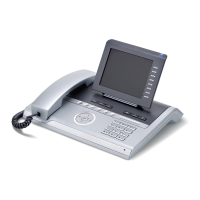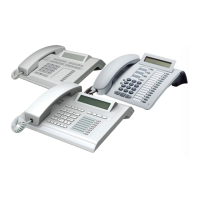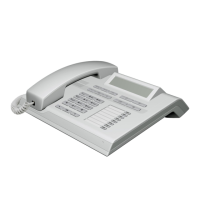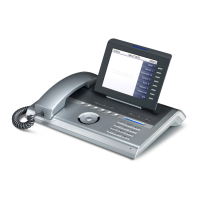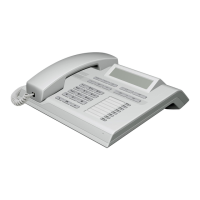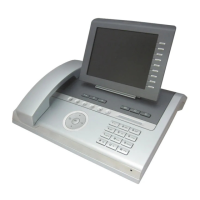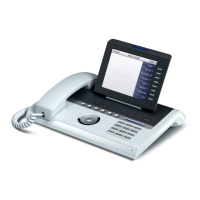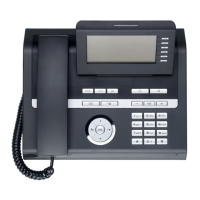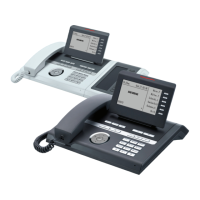
Do you have a question about the Siemens OpenStage 20 T and is the answer not in the manual?
| Keypad | Yes |
|---|---|
| Speakerphone | Yes |
| Headset Port | Yes |
| Wall Mountable | Yes |
| Connectivity | TDM (Time Division Multiplexing) |
| Lines | 1 line |
| Supported Protocols | SIP |
| Weight | 0.8 kg |
| Display | Graphical, monochrome, 2 lines |
| Type | Digital telephone |
Information on CE marking and proper disposal of electrical and electronic equipment.
Explains the purpose and scope of the user guide, including what the document covers.
Information on how to obtain assistance for phone problems and questions.
Defines the proper usage of the OpenStage phone and specifies the model type.
Advice on how to achieve optimal speakerphone performance and clear display visibility.
Introduces the main operating elements and displays of the OpenStage 20 T phone.
Details the functions of various key types including Function, Mailbox/Menu, and Audio keys.
Explains the operation of the 3-way navigator and the keypad for input.
Describes the use of special multi-function keys like asterisk and hash.
Provides a guide to entering characters using the keypad, including alphabetic labeling.
Explains the phone's idle mode display and how to navigate the idle menu.
Covers sending and receiving text messages, and signals for new messages.
Explains how voicemail messages are indicated and accessed on the phone.
Describes how call attempts are stored and displayed in the caller list.
Details how to access and navigate the phone's Program/Service menu.
Explains how to answer calls using the handset, including ring signaling details.
Instructions for answering calls using the loudspeaker and adjusting volume.
Steps on how to terminate an active call using the phone.
Describes how to transition between using the handset and the speakerphone during a call.
How to allow others in the room to join or listen to an ongoing call.
Covers off-hook and on-hook dialing procedures for internal and external calls.
Instructions for redialing the last dialed numbers and accessing saved station numbers.
How to reject calls that you do not wish to take.
Explains how to turn the microphone on and off during calls for privacy.
Procedures for calling a second party (consultation) and setting up three-party conferences.
Steps to transfer an ongoing call to another person or colleague.
How to set up call forwarding to different internal or external destinations.
Instructions for configuring call forwarding when calls are not answered.
Describes call forwarding via the carrier network using multiple subscriber numbers.
How to request a callback when a line is busy or unanswered.
Procedures for viewing and deleting saved callback requests.
How to intercept and answer calls directed to another colleague.
Using the speakerphone and enabling/disabling handsfree answerback.
Interacting with entrance telephones and opening doors remotely.
Steps to activate or deactivate the door opener function.
How to enter numbers before dialing and correct them if necessary.
Procedures for retrieving, viewing, and removing entries from the caller list.
How to search and dial numbers from the phone's internal directory.
Using the LDAP directory for searching and dialing contacts (not for HiPath 500).
How to view and refine search results from directories.
Instructions for using system speed-dial numbers and configuring speed-dial keys.
How to make a loudspeaker announcement to a colleague.
Using discreet calling and setting up automatic hotline connections.
How to assign specific numbers for outgoing external calls.
Using dialing aids connected to the phone or using the phone as a dialing aid.
Handling incoming calls while already on a call, including accepting or rejecting.
Managing call waiting tones and saving numbers for future redialing.
How to park calls and retrieve them from other phones.
Steps for initiating and managing multi-party conference calls.
Procedures for leaving or ending conference calls.
Using DTMF signals for device control and suffix dialing.
Transferring calls after announcing them to a group of users.
Activating ISDN services using trunk flash signals.
Managing call waiting (camp-on) and busy override scenarios.
Setting up and managing night answer services for call forwarding.
How to view call charges during or after a call.
Information on viewing connection charges for recent and total calls.
Assigning external calls to specific projects using account codes.
Activating and deactivating the ringer to silence incoming calls.
How to activate or deactivate the "Do Not Disturb" mode.
Preventing your station number or name from appearing on external displays.
Joining ongoing calls to monitor them silently (not for HiPath 500).
Monitoring rooms via phone and identifying anonymous callers.
Securing your phone against unauthorized use by locking it.
Locking and unlocking other telephones remotely.
Setting and saving a Personal Identification Number (PIN) for phone functions.
Configuring the phone to provide reminders for appointments.
Setting up and managing timed reminders for specific times.
Creating, sending, and managing short text messages.
How to view transmitted messages and incoming messages.
Leaving and deleting advisory messages on the phone's display.
Using your phone remotely to make outgoing calls from another telephone.
Moving your phone number to a new telephone or location.
Performing a system-wide cancellation of various phone functions.
Remotely activating or deactivating functions on other phones.
Accessing and controlling system functions remotely using DISA.
Accessing ISDN functions using specific codes via keypad dialing.
Controlling computers, programs, or data services from the telephone.
Communicating with PC applications using the CSTA interface.
Controlling external devices via relays on HiPath 3000 systems.
How sensors recognize signals and interact with the phone.
Locating people via pocket receivers using paging equipment.
Managing participation in group calls and hunt groups.
How to accept calls intended for other team members.
Setting up ringing groups to alert multiple phones for incoming calls.
Logging in/out and managing availability for UCD call distribution.
Requesting work time, controlling night service, and displaying waiting calls in UCD.
Procedures for leaving hunt groups or group calls within a LAN environment.
Associating with and managing multiple groups connected via HiPath 3000.
Activating and deactivating "follow me" call forwarding from other phones.
Setting up night answer functionality using HiPath 3000 systems.
Managing ringing groups across different HiPath 3000 platforms.
Controlling relays on HiPath 3000 systems from another phone.
Activating the door opener function on HiPath 3000 systems.
Adjusting the display angle and contrast for optimal readability.
Optimizing receiving volume, ring volume, and ring tone settings.
Adjusting speakerphone acoustics and activating/deactivating the ringer.
Changing the language used for system functions on the phone.
Performing a test to verify all phone functions are operating correctly.
Explains common error messages and their possible causes and reactions.
Guidance on when and how to contact service personnel for unresolved problems.
Addresses issues like unresponsive keys, no ringing, and inability to dial externally.
Instructions on how to properly clean and maintain the telephone.
